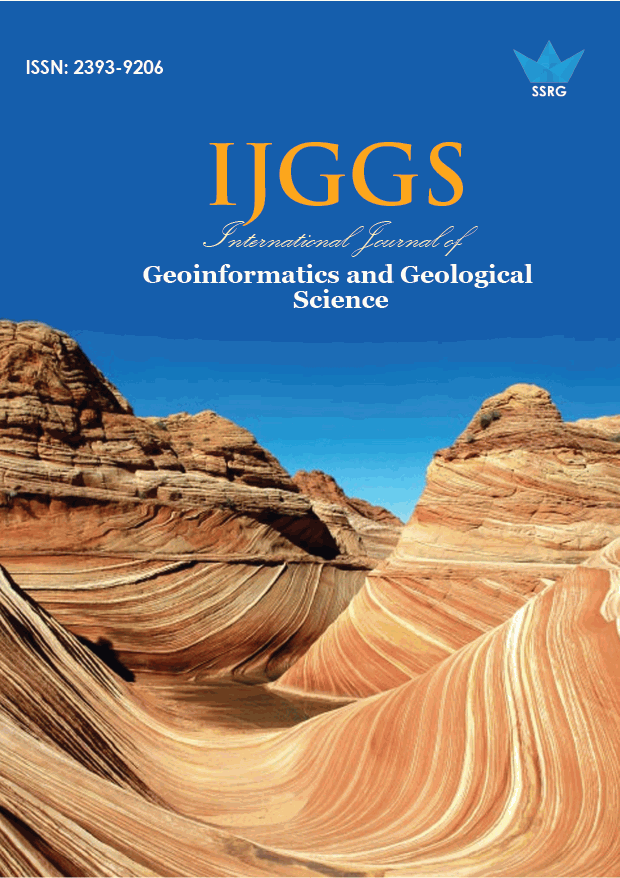The Geochemistry and Petrogenesis of the Kofayi Younger Granite Complex, Central Nigeria

| International Journal of Geoinformatics and Geological Science |
| © 2019 by SSRG - IJGGS Journal |
| Volume 6 Issue 3 |
| Year of Publication : 2019 |
| Authors : Aga, T, Haruna, A. I. |
How to Cite?
Aga, T, Haruna, A. I., "The Geochemistry and Petrogenesis of the Kofayi Younger Granite Complex, Central Nigeria," SSRG International Journal of Geoinformatics and Geological Science, vol. 6, no. 3, pp. 1-6, 2019. Crossref, https://doi.org/10.14445/23939206/IJGGS-V6I3P101
Abstract:
The Kofayi Younger Granite Complex is one of the fifty three (53) anorogenic granite suite in Nigeria which intruded the Precambrian Basement Complex. The complex is found to comprise of felsic rocks like; biotite-granites, biotite micro granites, hornblende and biotite granites. The complex is also found to be associated with mafic rocks like diorites which, at some portions have formed hybrid rocks. The geochemistry of sixteen (16) representative rock samples was carried out on the energy dispersive x-ray fluorescence (EDXRF) for twelve (12) major and thirty seven (37) trace and REE elements. Agpaitic index and alumina saturation index suggest that the rocks are peraluminous. The widely used SiO2 vs K2O classify most of the granite samples as high K rocks while the mafic diorites are calc-alkaline. Discrimination diagrams for tectonic interpretation of granitic rocks ((Na2+K2O)/CaO vs Zr+Nb+Ce+Y and Nb vs Y, suggest that all the samples are WPG, as well as A-type granites. The enrichment of high field strength (HFS) elements in the investigated granites confirms their A-type identity and exclude them from other granitic types. Spidergraph show negative Sr anomaly suggesting the feldspar fractionated nature of the granitoids where plagioclase played an important role in the evolution of the A-type magmatism. The magma that gave rise to the granitoids most likely came from the lithospheric mantle.The enrichment of Zr and Nb in the rocks indicate Nb-Sn-W mineralization. The northern part of the Complex contains Pb>15 which confirms that it are tin-bearing or productive granitoid suite.
Keywords:
A-type, Anorogenic, Granite, Kofayi, Mineralization.
References:
[1] Aga, T. and Haruna, I.A. (2019): The Geology and Petrography of the Kofayi Younger Granite Complex, Central Nigeria. International Journal of Advanced Geosciences. 3 (2). Pp. 15-27.
[2] Castro, A., Moreno-Ventas, I. and de la Rosa, J.D. (1991): H-type (Hybrid) Granitoids: A proposed Revision of the Granite-type Classification and Nomenclature. Earth-Science Reviews 31. Pp 237-253.
[3] Collins, W. J., Beams, S.D., White, A.J.R. and Chappell, B.W. (1982): Nature and origin of A-type granites with particular reference to Southeastern Australia. Contributions to Mineralogy and Petrology. Vol. 80. Pp. 189-200.
[4] Eby, G.N. and Kochhar, N. (1990): Geochemistry and Petrogenesis of the Malani Igneous Suite, North Peninsular India. Journal of Geological Society of India, Vol. 36. Pp. 109-130.
[5] Frost, B. R., Barnes, C. G., Colins, W.J., Arculus, R.J., Ellis, D.J. and Frost C.D. (2001): A geochemical classification for granitic rocks. Journal of Petrology. Vol. 42. Pp. 2033-2048.
[6] Kinnaird, J.A. (1985): Hydrothermal Alteration and Mineralization of the Alkaline Anorogenic Ring Complex of Nigeria. Journal of African Earth Science. Vol. 3. Pp. 229 – 251.
[7] Loiselle, M.C. and Wones, D.R. (1979): Characteristics and Origin of Anorogenic Granites. Geological Society of America Abstracts with Programs. Vol. 11. P 468.
[8] Macleod, W.N; Turner, D.C and Wright, E.P. (1971). The Geology of Jos Plateau. Geol. Surv. Nigeria Bull. No.32.Vol.2. 160pp.
[9] McDonough, W.F. and Sun, S.S. (1995). The Composition of the Earth. Chemical Geology. Vol 120. Pp 223-253.
[10] Maniar, P.D and Piccoli, P.M (1989). Tectonic Discrimination of Granitoids. Geological Society, American Bulletin. No 101. Pp 635-643.
[11] Middlemost, E.A. (1985): Magmas and Magmatic Rocks. An Introduction to Igneous Petrology. Longman Group, UK. Pp. 73-87.
[12] Pearce, J.A. and Norry, M.J. (1979): Petrogenetic Implications of Ti, Z, Y and Nb variations in volcanic rocks. Contributions to Mineralogy and Petrology. Vol. 69. Pp. 33-47.
[13] Pearce, J.A; Harries, N.G and Tindale, A.G (1984): Trace Element Discrimination Diagrams for the Tectonic Interpretation of Granitic Rocks. Journal of Petrology.Vol.25. Pp. 956-983.
[14] Ragland P.C. (1989): Basic Analytical Petrology. Oxford University Press. New York.
[15] Shand, S.J. (1947): Eruptive Rocks. Their Genesis, Composition, Classification, and Their Relation to Ore-Deposits. J. Wiley & Sons, New York.
[16] Stern R.J and Gottfried D. (1989): Discussion of the paper “Late Pan- African Magmatism and Crustal Development in Northeastern Egypt”. Geological Journal. Vol. 24. Pp. 371–374.
[17] Whalen, J. B., Currie, K. L. and Chappell, B. W. (1987): A - type granites: Geochemical characteristics, discrimination and petrogenesis. Contributions to Mineralogy and Petrology. Vol. 96. Pp. 407-419.
[18] Wilson, M. (1989): Igneous Petrogenesis: A Global Tectonic Approach. Unwin Hyman Ltd.

 10.14445/23939206/IJGGS-V6I3P101
10.14445/23939206/IJGGS-V6I3P101